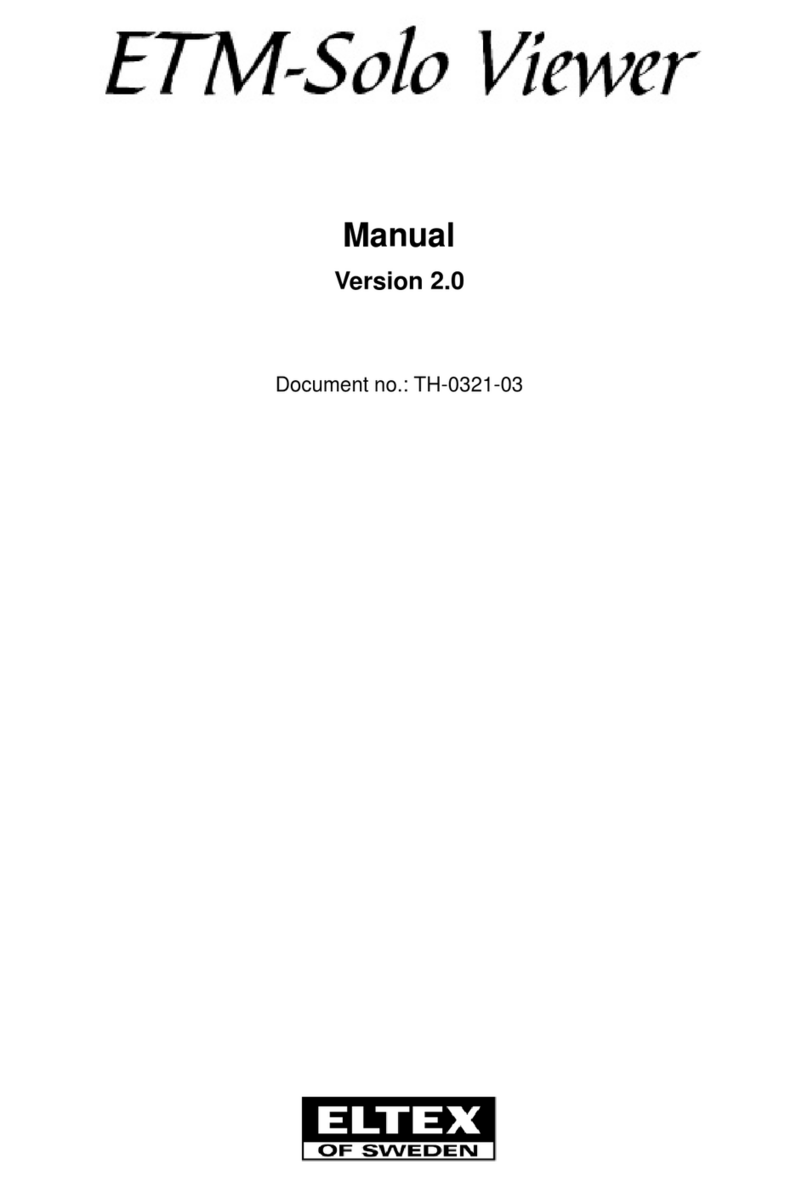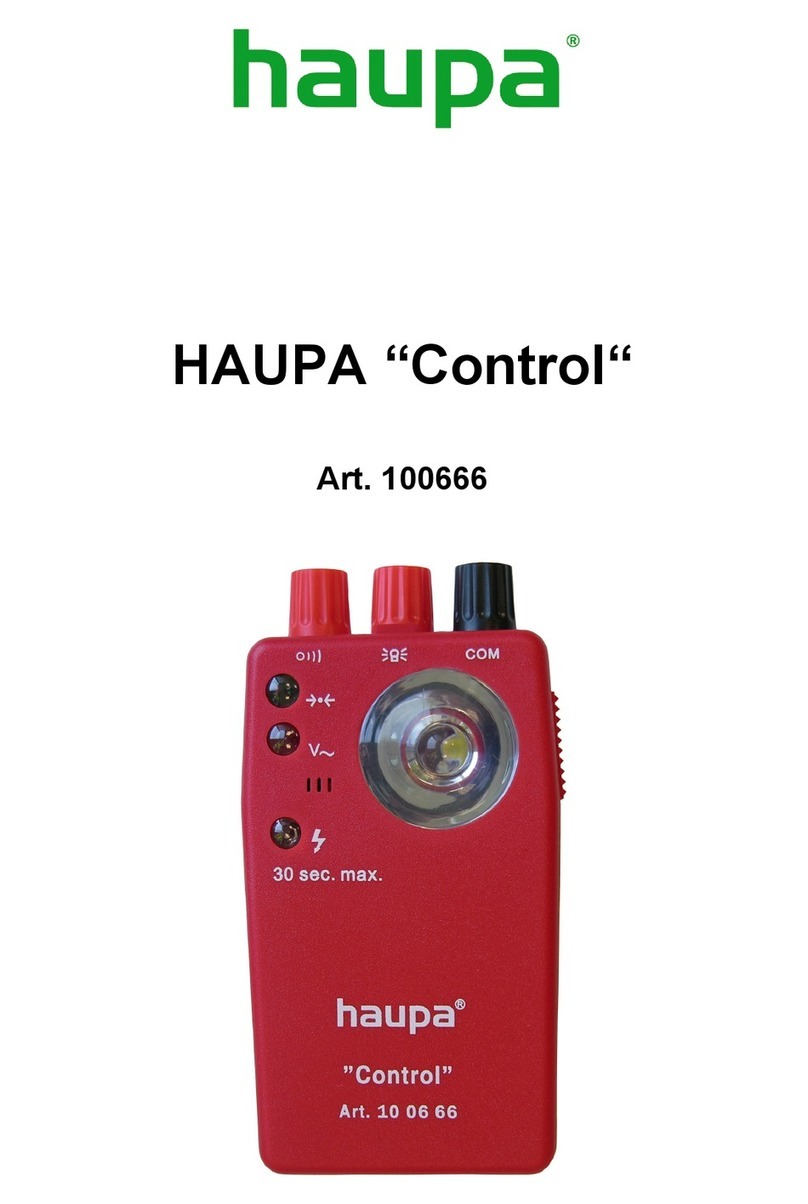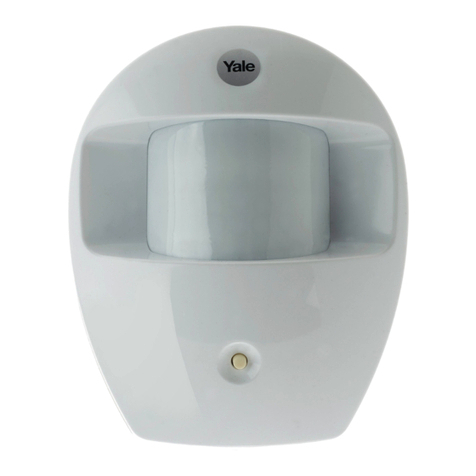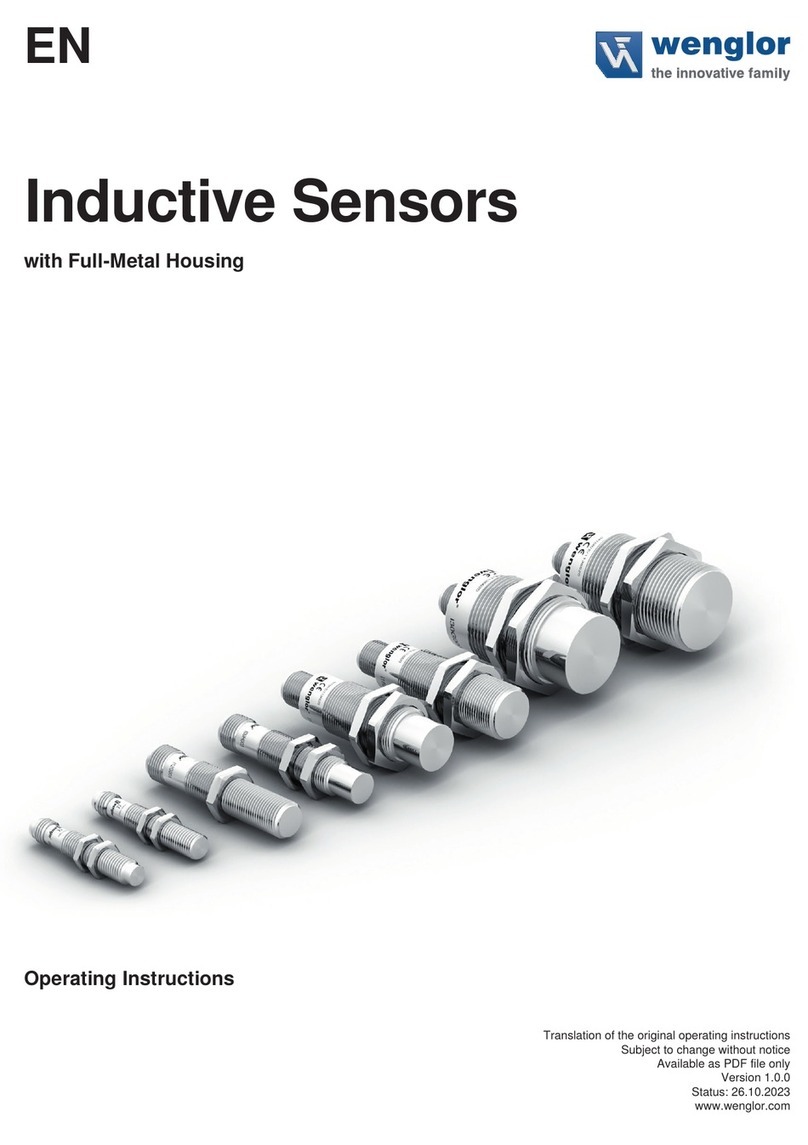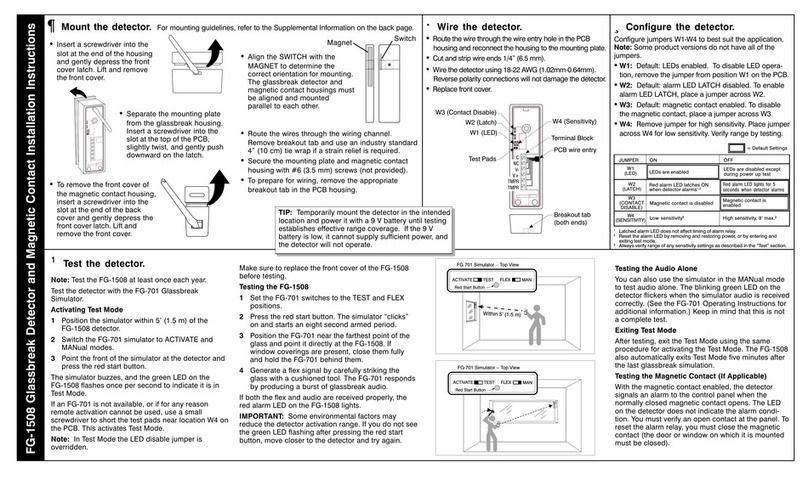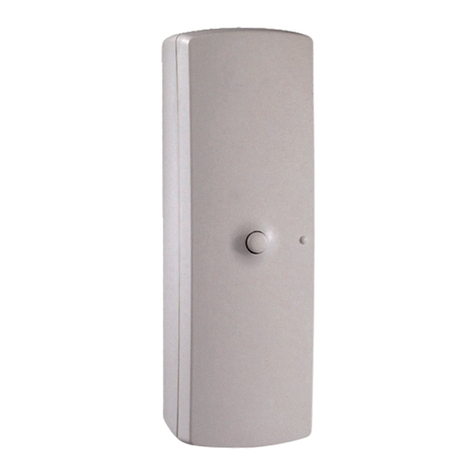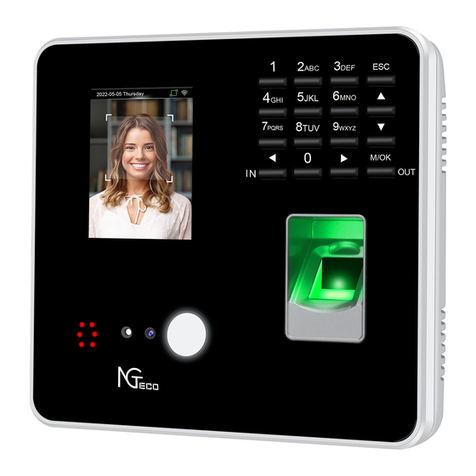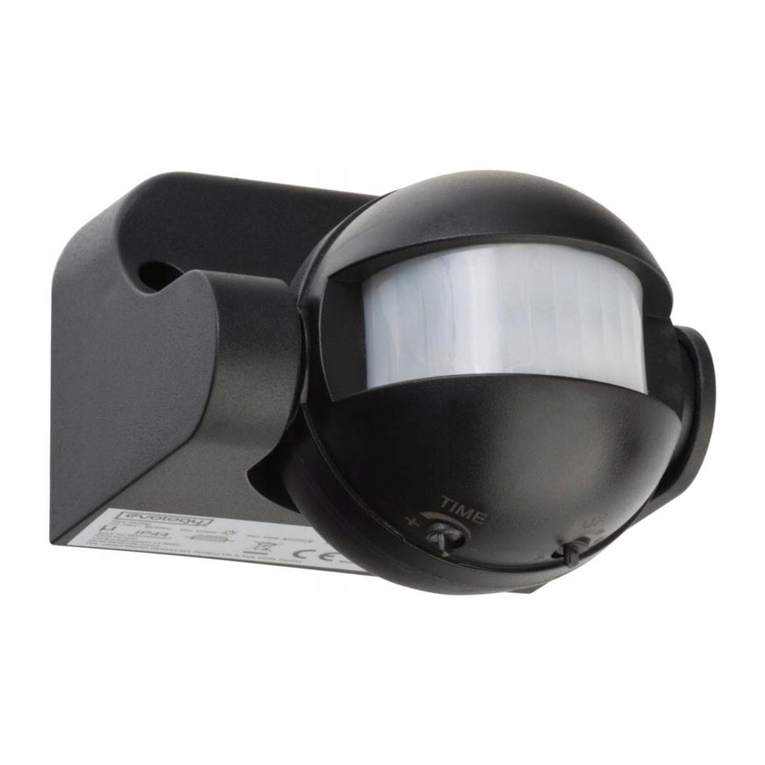Baur PD-SGS User manual

BAUR GmbH ▪Raiffeisenstr. 8 ▪6832 Sulz, Austria
T +43 5522 4941-0 ▪F +43 5522 4941-3 ▪www.baur.eu ▪headoffice@baur.at
User manual
Handheld
Online PD Detector
PD-SGS
(supervisor)

© 2018
All rights reserved.
Reproduction, circulation in any form whatsoever, publishing on online services or Internet, as well as
duplication on data carriers, even in extracts or with changed format is allowed only with prior written
permission of BAUR GmbH, A-6832 Sulz / Austria.
We reserve the right in the interests of our customers to make amendments as a result of further
technical development. Illustrations, descriptions and scope of supply are therefore not binding.
The names of products and companies are the trademarks or brand names of the relevant companies.

PD-SGS Table of c ontents
822-162-1 iii / 46
Table of contents
1General.......................................................................................................... 5
1.1 Using this manual ................................................................................ 5
1.2 Structure of safety instructions ............................................................ 5
1.3 Symbols used ...................................................................................... 7
1.4 Note on the screenshots and graphics used ....................................... 7
1.5 Warranty .............................................................................................. 7
1.6 After Sales Service .............................................................................. 7
2For your safety............................................................................................. 8
2.1 Instructions for the user ....................................................................... 8
2.2 Intended use ........................................................................................ 8
2.3 Avoid dangers, take safety measures.................................................. 9
2.3.1 Dangers when working with high voltage during online
measurements ..................................................................... 10
2.4 Special personal protection equipment.............................................. 12
3Product information .................................................................................. 13
3.1 PD-SGS ............................................................................................. 13
3.2 Partial discharge ................................................................................ 13
3.2.1 Radiated energy................................................................... 14
3.3 Full illustration .................................................................................... 14
4PD-SGS overview....................................................................................... 15
4.1 PD-SGS outline.................................................................................. 15
4.2 PD-SGS Input/Output ........................................................................ 15
5Transient Earth Voltage (TEV).................................................................. 16
5.1 Capacitive Coupler sensor................................................................. 16
5.2 Specification....................................................................................... 16
6Acoustic Emission (AE) ............................................................................ 17
6.1 Surface Tracking................................................................................ 17
6.2 Acoustic sensor.................................................................................. 17
6.3 Specification....................................................................................... 17
7Operational control.................................................................................... 18
7.1 Control buttons................................................................................... 18
7.2 On/Off button ..................................................................................... 18
7.3 Battery level indication ....................................................................... 19
7.4 MODE button ..................................................................................... 19

Table of c ontents PD-SGS
iv
/ 46 822-162-1
7.4.1 TEV mode ............................................................................ 19
7.4.2 TEV noise detection ............................................................. 20
7.4.3 AE mode .............................................................................. 20
7.5 Display ............................................................................................... 21
7.5.1 Level display ........................................................................ 21
7.5.2 Trend display........................................................................ 22
7.5.3 Setting the volume ............................................................... 23
8Charging the device .................................................................................. 24
9Checking the PD-SGS function ................................................................ 25
9.1 Function tester PD-FT........................................................................ 25
9.2 Checking the TEV function ................................................................ 26
9.3 Checking the AE function .................................................................. 27
10 Surveying switchgear panels for PD – TEV ............................................ 28
10.1 Examples for checking TEV activity levels ........................................ 29
11 Surveying switchgear panels for PD – AE .............................................. 31
12 Parabolic reflector (optional).................................................................... 32
12.1 Assembling and commissioning ........................................................ 33
12.2 Using the parabolic reflector .............................................................. 34
12.3 Maintenance and Servicing ............................................................... 35
12.4 Calibration.......................................................................................... 35
12.5 Laser pointer extension kit (optional)................................................. 36
13 Disposing of the device ............................................................................ 37
14 Technical data............................................................................................ 38
15 Delivery includes and Options ................................................................. 40
16 Declaration of conformity ......................................................................... 41
17 Appendix .................................................................................................... 42
18 Index............................................................................................................ 44

PD-SGS General
822-162-1 5 / 46
1.1 Using this manual
This user manual contains all necessary information that is needed for the commissioning
and operation of the described product.
Read this user manual completely before operating the product for the first time.
Consider this user manual to be a part of the product and store it in an easily accessible
location.
If this user manual is lost, please contact BAUR GmbH or your nearest BAUR
representative (http://www.baur.eu/baur-worldwide).
Applicable documents
If the PD-SGS is delivered together with the optional parabolic reflector and the laser pointer
extension kit, this user manual must be applied only with the user manuals of all components
comprised.
1.2 Structure of safety instructions
The safety instructions in this user manual are presented as follows:
Danger
symbol
SIGNAL WORD
Type of danger and its source
Possible consequences of violation.
Measure to prevent the danger.
1 G
ENERAL

General PD-SGS
6
/ 46 822-162-1
If a dangerous situation could arise at a specific step, the safety instruction is displayed
immediately before this dangerous step and is shown as follows:
SIGNAL WORD
Type of danger and its source
Possible consequences of violation.
Measure to prevent the danger.
Danger levels
Signal words in the safety instructions specify the danger levels.
DANGER Will lead to severe injuries or death.
WARNING May lead to severe injuries or death.
CAUTION May lead to light to moderate injuries.
NOTICE May lead to material damage.
Danger symbols
General danger
Risk of electric shock
Risk of falling

PD-SGS General
822-162-1 7 / 46
1.3 Symbols used
Symbol Meaning
You are prompted for an action.
1.
2.
...
Perform the actions in this sequence.
a.
b.
...
If an operation consists of several operating steps, specify these
with "a, b, c".
Perform the operating steps in this sequence.
1
2
...
Numbering in the legend
List
Indicates extensive information on the topic in the corresponding
user manuals.
1.4 Note on the screenshots and graphics used
The screenshots and graphics used are intended to illustrate the procedure and may
therefore differ slightly from the actual state.
1.5 Warranty
For warranty claims, please contact BAUR GmbH or your local BAUR representative
(http://www.baur.eu/baur-worldwide). Warranty is cancelled in case of misuse.
1.6 After Sales Service
For questions contact BAUR GmbH or your BAUR representative (http://www.baur.eu/baur-
worldwide).
BAUR GmbH
Raiffeisenstraße 8
A-6832 Sulz / Austria
service@baur.at
www.baur.eu

For your safety PD-SGS
8
/ 46 822-162-1
All BAUR devices and systems are reliable and are manufactured as per state-of-the-art
technology. The individual parts and the finished devices are subject to continuous testing by
our qualified personnel as part of our quality assurance system. Each device is fully tested
before delivery.
However, the operational safety and reliability in practice can be achieved only when all
necessary measures have been taken. The responsible body1and operator2of the device or
system are responsible for planning these measures and monitoring their implementation.
Before operating the device or system you should read and understand this user manual and
the user manuals of all integrated devices.
2.1 Instructions for the user
The product may be operated only by authorised and trained electrical engineers. An
electrical engineer is a person who owing to his professional education (electrical
engineering), knowledge, experience and acquaintance with the applicable standards and
regulations can assess the tasks assigned to him and detect possible dangers.
In addition, the user must have:
Knowledge of the technical equipment and operation of the PD-SGS
Knowledge of the testing and measurement procedures
Knowledge of plant engineering (cable types, switchgear, etc.).
2.2 Intended use
The BAUR handheld online PD detector PD-SGS is used to conduct rapid initial tests for PD
activities on live switchgear.
If the device is used without observing this condition, safe operation cannot be guaranteed.
The operator or user is liable for any damage to persons and property resulting from
incorrect operation.
Proper use also includes
Compliance with all instructions in this user manual,
Compliance with the technical data and connection requirements given on the rating
plate and in the user manual,
Compliance with the inspection and maintenance tasks.
1Responsible body is the person or group that is responsible for the safe operation of the device and its
maintenance (EN 61010, 3.5.12).
2Operator is the person who uses the device for its intended purpose (according to the definition of user in
compliance with EN 61010, 3.5.11).
2 F
OR YOUR SAFETY

PD-SGS For your safety
822-162-1 9 / 46
2.3 Avoid dangers, take safety measures
When operating the PD-SGS observe the following rules and guidelines:
Accident prevention and environment protection rules applicable for your country
Safety instructions and regulations of the country where the PD-SGS is being used
(according to the latest version)
EU/EFTA countries: EN 50110 “Operation of electrical installations”
Other countries: the standard for operating electrical systems applicable for your country
If necessary, other national and international standards and guidelines in accordance
with the latest applicable version
Local safety and accident prevention regulations
Liability insurance association regulations (if any).
Technically secure state of the device
Safety, function and availability depend on the proper condition of the device. Upgrades,
modifications or alterations to the product are prohibited.
Operate the device only in a technically perfect condition.
In the case of damage and/or malfunction, immediately stop the device, identify
accordingly and have the faults rectified by appropriately qualified and authorised
personnel.
Comply with the inspection and maintenance conditions.
Use only accessories and original spare parts recommended by BAUR. The use of spare
parts, accessories and optional extras that are not tested and approved by BAUR could
adversely affect the safety, function and characteristics of the product.
Never take apart the device. The device does not contain any components that could be
serviced or repaired by the user.
Do not operate under damp or humid conditions
Condensation can form in devices and systems due to temperature fluctuations and high air
humidity, which in some components can lead to leakage currents and flashovers.
Maximum danger arises when relatively high air humidity and temperature fluctuations occur
consecutively, e.g. which is the case when storing the device in an unheated room or when
placed outdoors. Then when the device is exposed to a high ambient temperature, the cold
surfaces of the device cool the air in the immediate vicinity, which leads to the formation of
condensation, even inside the device.
Therefore, two factors are crucial:
The higher the relative air humidity, the faster the dew point is reached and water is
condensed.
The higher the temperature difference between the surfaces and the ambient air, the
more likely condensation will occur.
To prevent condensation, always temper the device and system before and during
measurements to minimise the risk of condensation.

For your safety PD-SGS
10
/ 46 822-162-1
Working in dangerous environment: working at height
If performing connection and measurement tasks at workplaces that are more than 1 m
above ground, special safety measures must be taken to prevent falls from height occurring.
DANGER
Danger of falling while working at heights
Danger to life, risk of injury due to fall
Secure workplaces posing risk of falling with safety devices (e.g.
railings, platforms, scaffolds, frameworks).
Cover or block places where there is danger of falling or tripping.
Tasks performed at heights must be supervised by a second
person.
2.3.1 Dangers when working with high voltage during online measurements
A PD test with the PD-SGS is carried out on a live test object. Personnel need to pay special
attention and must be very careful while working with high electric voltage.
During the preparation and while performing the measurement, the user can come close to
live parts. Consequently, there is danger of touching the active parts directly or indirectly.
Commissioning and operation of the PD-SGS are permitted only in compliance with
EN 50110 (EU/EFTA countries) or with standards applicable in your country. Also observe
the applicable national and local accident prevention regulations.

PD-SGS For your safety
822-162-1 11 / 46
DANGER
Working in the vicinity of adjacent live parts
Danger to life or risk of injury due to electric shock
Before commencing work, the responsible body or operator must
assess the danger for the specific working conditions. Protective
measures are based on the risk assessment and must be followed
at the workplace.
Only accredited personnel with appropriate Health and Safety
training should use the equipment.
Do not use the equipment if it is damaged, or its safety is impaired
in any way.
Inspect and test all earthing and signal cables for continuity.
The user should have read and understood the appropriate
equipment manuals.
Always select the appropriate sensor and sensor connection for the
application.
When taking the measurement, protection must be guaranteed for
all plant parts, either
through safety devices, insulating cover material
or by adhering to the necessary safety distances. Safety
distances depend on the voltage level, plant model, personnel
qualification and available space. In this regard, comply with
EN 50110 or the applicable standards in your country as well
as the relevant national and local accident prevention
regulations.
The device has been designed for use only on the earthed, outer
surface of metal-clad equipment and the earthed/neutral
connections of cables/switchgear.
Under no circumstances should the sensors be connected to the
high-voltage terminals of HV plant under test.
Do not disturb or interfere with the high-voltage equipment in any
way.
Working in the vicinity of open cables or faulty systems is forbidden.
Notify the responsible authorities immediately.
Never take the safety devices out of operation. It is forbidden to
bypass the safety devices.
Keep the measurement tasks as short as possible.
Use suitable personal protection equipment to protect against
electric hazards.
To assess the local conditions adequately, provide sufficient
lighting at the work place.

For your safety PD-SGS
12
/ 46 822-162-1
Guaranteeing immediate measures in case of danger
The device may be connected and operated only if a second person with visual and auditory
contact to the tester is present and is in the position to detect possible dangers and to act
immediately and appropriately.
Access
The test engineers shall only enter the customer’s switchyard or substation after they have
received permission from an authorised person appointed by the plant owner. If in doubt
about any matter the plant owner’s high-voltage safety rules should be consulted by the test
engineers who will carry out the testing.
Visual inspection of substation
On entry to the test area a visual inspection of the area should be carried out by the test
engineers. This should enable the operator to identify any potential hazards in the area and
to assess both the type of equipment to be tested and the method of doing so. Only when
this visual inspection has been completed can the equipment be set-up for testing.
2.4 Special personal protection equipment
Personal protection equipment based on the risk assessment for the relevant working
conditions are part of the PD-SGS safety concept.
Observe the national safety regulations and your company’s working and operating
instructions.
Depending on the conditions of the work place, use the following safety equipment:
Protection against electrostatic charging, crushing,
slipping and other accidents: Safety hood
Protection against electrical hazards (arcing fault): Certified safety clothing
Hard hat with visor
Insulating protective gloves
LV HRC fuse handle with sleeve
Protection against noise: Ear protection
Protection against dangers from road traffic: High visibility vest according to EN 471
(Protection class 2) or according to the
applicable standards in your country for
high visibility clothing for commercial use.
No high visibility vest during tasks with
risk of arcs!
Hand protection: Safety gloves

PD-SGS Product information
822-162-1 13 / 46
3.1 PD-SGS
The BAUR handheld online PD detector PD-SGS is a first level partial discharge (PD)
detection device designed for use in distribution voltage substations. It enables network
operators to carry out simple routine tests that will identify discharge activity in switchgear
and accessories.
The battery-operated portable device has a live display that shows a quantified level of
detected PD activity. A colour-coded traffic light system indicates when detected levels
exceed the pre-set thresholds.
The PD-SGS has a built-in TEV sensor for capacitive coupling to switchgear and a built-in
ultrasonic sensor for detection of surface discharge and tracking. Headphones are also
supplied to help the user when working in noisy environment.
The PD-SGS is supplied with a battery-operated function tester PD-FT that should be used
to verify the correct operation of the device before use.
The PD-SGS is a non-intrusive test device therefore PD can be identified and located whilst
the equipment remains live.
3.2 Partial discharge
Partial discharge (PD) is an electrical discharge that does not completely bridge the space
between two conducting electrodes. The discharge may be in a gas filled void in a solid
insulating material, in a gas bubble in a liquid insulator or around an electrode in a gas.
When partial discharge occurs in a gas, it is usually known as corona.
Partial discharge is generally accepted as the predominant cause of long term degradation
and eventual failure of electrical insulation. As a result, its measurement is standard as part
of the factory testing of most types of high-voltage equipment. In-service monitoring of
equipment for PD gives an advance warning of pending insulation failure. This allows a plant
operator to take remedial action during planned outages.
Partial discharge often occurs under normal working conditions, gradually deteriorating the
dielectric until it can no longer withstand the electrical stress and fails. By detecting this PD
activity while the equipment is in operation, failure can be avoided.
3 P
RODUCT INFORMATION

Product information PD-SGS
14
/ 46 822-162-1
3.2.1 Radiated energy
A PD event will radiate energy in different forms and this energy can be picked up by the
PD-SGS in order to detect the source and locate it.
Electromagnetic radiation
PD creates electromagnetic (EM) radiation that dissipates in all directions away from the
source. Metal components, for instance the panels around switchgear, will pick up this
radiation and small voltages called Transient Earth Voltages (TEVs) are induced on the
surface. These very high frequency signals will be picked up by the PD-SGS and indicate
that there is a PD source nearby.
Acoustic radiation
Partial discharge also generates acoustic energy across a wide band of frequencies. This
acoustic energy can be detected in the ultrasonic range when there is a ‘line of sight’
between the PD source and the detecting sensor. Sharp points, for instance on air insulated
cable terminations, are typical sources of corona that will produce acoustic emission. Cast
insulators are prone to surface tracking where electrical stress across the insulator’s surface
causes discharge, and deteriorates the insulator surface and creates carbon tracks. This can
lead to flashover and failure of the equipment.
3.3 Full illustration
1 Transport case
2 Handheld online PD detector PD-SGS
3 PD-SGS power supply / charger
4 Function tester PD-FT
5 Stereo headphones

PD-SGS PD-S GS overview
822-162-1 15 / 46
4.1 PD-SGS outline
The PD-SGS has a tough ABS enclosure with rubber protective covering around the PD
sensors. Both built-in PD sensors are mounted at the front of the device so that they can be
easily directed at the inspection point. The PD-SGS is controlled with two membrane
switches on the front panel and a trigger button underneath. An OLED type screen is used
for function control and providing both text and graphical output information to the user. In
addition the PD-SGS has an audio output through both a built-in speaker and pluggable
headphones.
The unit is powered by a lithium-ion rechargeable battery giving a life of over 12 hours of
use. The software has intelligent power management prolonging battery life.
4.2 PD-SGS Input/Output
The PD-SGS has an input and output as detailed in the tables below:
Front panel Type
Display OLED display
6 x PD level LEDs
Control button MODE Membrane switch
On/Off button Membrane switch
Side panels Type
Headphone socket 3.5 mm jack
External AE sensor 3.5 mm jack
Handle Type
Trigger button Push button
Power charge socket 2.1 mm DC power
4 PD-SGS
OVERVIEW

Trans ient E arth V oltage (TE V ) PD-SGS
16
/ 46 822-162-1
Partial discharge activity inside a metal-clad high-voltage plant induces small voltage
impulses called Transient Earth Voltages on the surface of the metal cladding. These TEVs
travel around the cladding surface to the outside of the gear where they can be picked up
using capacitively coupled transducers.
The TEV signals emerge at the joins between the metal panels and it is at these points that
the highest readings are generally detected.
Figure: PD pulse propagation in AIS panels
5.1 Capacitive Coupler sensor
The built-in Capacitive Coupler sensor detects TEVs as they pass over the cladding of the
high-voltage plant. The very fast transient signals are detected by the PD-SGS and their
magnitude is measured and displayed.
5.2 Specification
Specification
Sensor Capacitive
Measurement range 0 – 80 dBmV
Frequency range 20 MHz – 200 MHz
Resolution 1 dB
Accuracy ±1 dB
5 T
RANSIENT
E
ARTH
V
OLTAGE
(TEV)

PD-SGS Acous tic E mis sion (AE )
822-162-1 17 / 46
Acoustic emission is ultrasonic energy that is emitted by discharges on electrical insulating
surfaces or sometimes called Surface Tracking.
6.1 Surface Tracking
Surface Tracking is the formation of a permanent conducting path across an insulator
surface. Usually the conducting path results from degradation of the insulation. Tracking
most readily occurs when the insulation is a carbon based compound.
A high-voltage plant is often very difficult to clean, so dirt and contaminants can build up over
time. In the presence of moisture, these contaminating layers give rise to leakage current
over the insulator surface. This heats the surface and through evaporation causes
interruption in the moisture film. Large potential differences are generated over the gaps in
the moisture film and small sparks can bridge the gaps. Heat from the sparks causes
carbonisation of the insulation and leads to the formation of permanent carbon tracks on the
surface. Under such conditions this process will develop over time and eventually lead to
flashover and full breakdown of the insulation.
6.2 Acoustic sensor
The ultrasonic acoustic sensor is designed for use on air-insulated terminations where there
is a clear sound path between the electrically stressed insulation and the probe. The sensor
is extremely sensitive when pointed directly at the discharge source.
The transducer is embedded into the rubber moulded cover at the front of the device so it
can be easily directed towards the parts of electrical plant where tracking may occur.
6.3 Specification
Specification
Measurement range -6 to +70 dBµV
Resolution 1 dB
Accuracy ±1 dB
Convertor sensitivity -65 dB (0 dB = 1 V/µbarrms sound pressure
level)
Convertor average frequency 40 kHz ± 1 kHz
6 A
COUSTIC
E
MISSION
(AE)

Operational control PD-SGS
18
/ 46 822-162-1
7.1 Control buttons
The PD-SGS is controlled by three buttons on the device as shown below:
1 MODE button
2 On/Off button
3 TRIGGER button
7.2 On/Off button
The On/Off button is used to turn the PD-SGS on and off.
Note that the On/Off button should be pressed and held down for two seconds before the
power is switched.
7 O
PERATIONAL CONTROL

PD-SGS Operational control
822-162-1 19 / 46
7.3 Battery level indication
The remaining charge in the battery is indicated by the small icon in the bottom right-hand
side of the display screen.
1 Battery level indication
7.4 MODE button
The MODE button is used to toggle the device between TEV mode and AE mode. The
MODE button should be pressed briefly in order to switch between the two modes.
7.4.1 TEV mode
In TEV mode, the device measures and displays the magnitude of TEV signals detected.
The measured value is shown in dBmV such that 0 dB = 1 mV. The relationship between
detected signal magnitude in dB and mV is shown in the table below:
mV dB
1 0
2 6
5 14
10 20
20 26
35 31
50 34
100 40
1 000 60
10 000 80

Operational control PD-SGS
20
/ 46 822-162-1
7.4.2 TEV noise detection
In TEV mode, the PD-SGS can identify HF signals that are from a noise source and are not
PD. When noise is detected, the display will alternate between the dB level recorded and the
indication Noise as shown in the figure below:
The noise detection algorithm is only applied to signals with a magnitude greater than 20 dB
as noise signals below this level are relatively common.
It should be noted that when high noise is detected, it can mask genuine PD. It is advisable
to use more sophisticated PD detection devices that can detect PD even in the presence of
high noise.
7.4.3 AE mode
In AE mode, the device measures and displays the magnitude of ultrasonic acoustic signals
detected. The measured value is shown in dBµV such that 0 dB = 1 µV. The relationship
between detected signal magnitude in dB and µV is shown in the table below:
µV dB
0.5 -6
1 0
2 6
5 14
10 20
20 26
35 31
50 34
100 40
1 000 60
3 100 70
Table of contents







